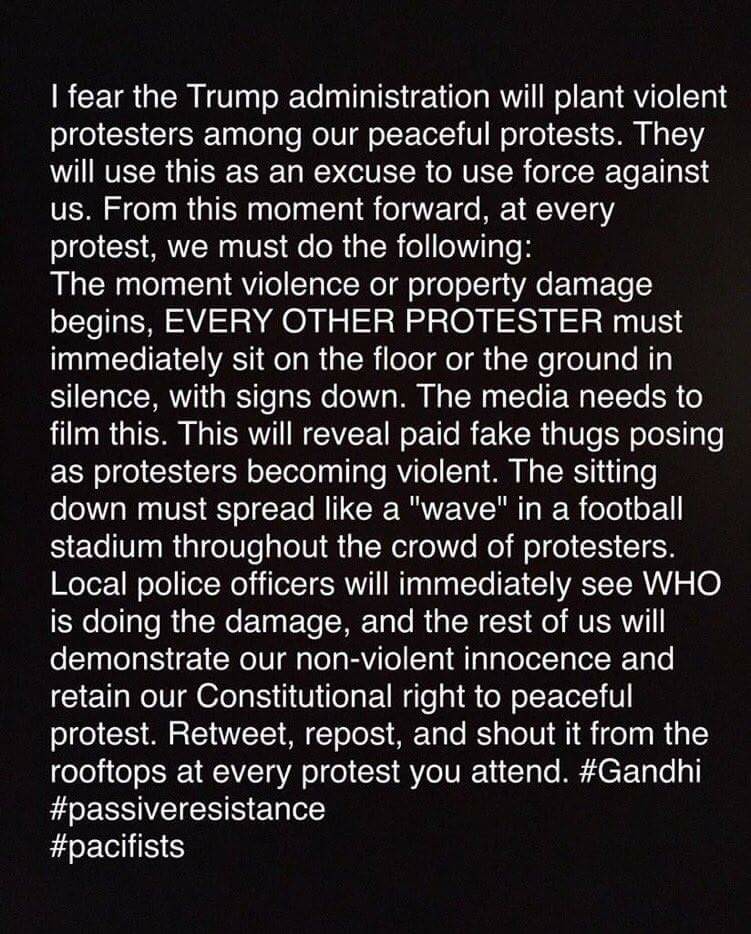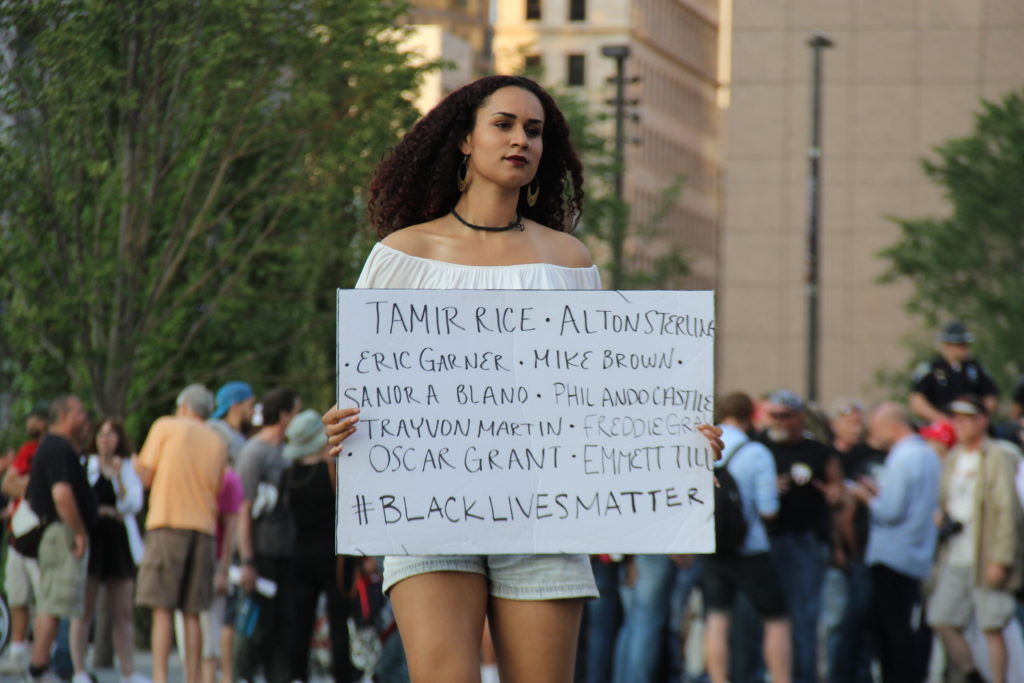The recent first anniversary of Donald Trump’s inauguration got me thinking about nonviolent activism and police.
My thoughts brought me back to 2011. Occupy Wall Street was a nonviolent movement, but when we started collaborating with other movements and activist groups, we quickly learned that one definition of nonviolence rarely matched another.
It seems simple on the surface: nonviolence means not physically attacking another person. Beyond that, things quickly break down. Is swearing at another person a form of verbal violence? Does a nonviolent person run from the police or does “nonviolent civil disobedience” mean staying to face the charges for whatever laws you might have broken? Is destruction of property also a form of violence, or is it another type of action which should be evaluated separately?
Different groups have answered these questions differently. One group of LGBTQIA activists I collaborated with frequently at Occupy Austin were initially a bit judgmental about the definition of nonviolence we used, especially our antagonism with the cops. They later came to an understanding (though not necessarily an embrace) of our ways after realizing that the police tended to treat Occupy with more violence and repression than when their group gathered for civil disobedience.
All of this comes to mind now as I watch various post-Trump “resistance” movements grapple with their relationship to the police or, more often, fail to do so.
Before I go further, I want to lay out my beliefs: I think nonviolence can be a valuable tactic in an activist’s toolbox, but I believe in diversity of tactics and I’ve openly supported antifascism, a broad movement or tactic which occasionally involves the use of violence in defense of communities under threat by nazis and white supremacists.
At the same time, I respect my friends who’ve chosen to focus on nonviolent activism, whether as part of their faith or just because of their principled decision. It’s for those of you that I write this, and I propose that you include the following in your definition of nonviolence:
Nonviolence means refusing to work with the police.
To put it simply: In my years of activism and journalism, it’s become quite clear to me that the single biggest purveyor of violence at protests are police. Police come to peaceful protests armed for war (literally, with military surplus gear), and police are better at turning a protest into riotous violence than any other group.
The physical violence they inflict is bad enough, but the subtle damage that cops do to justice movements is a form of violence too. In their love of protecting the government and corporate property and profits, police will infiltrate your movement, entrap your members, and do everything they can to tear you apart.
Arrests of activists ruin lives. Even charges hanging over a person can ruin their mental health — just ask any of the J20 defendants who have spent the last year wondering if they’d be spending decades in prison — regardless of the final outcome of the trials.
Cooperating with police ruins lives. Police and the Feds in Charlottesville have been charging left activists who previously assisted their investigation into nazis.
Police will show up at your protest whether you want them or not. But don’t cooperate with them. Don’t thank them for being there. And as any sensible lawyer will tell you, never talk to the cops.
Getting a permit for your march is just asking the state to commit violence on your behalf. So is asking them to arrest activists you disagree with. Protecting you is not the job of the cops, especially not at a protest. Their job is to maintain order and the status quo, and your permit won’t change that. They will attack you as soon as they feel you’re making a difference.
And asking the police to protect you means you won’t be as likely to protect each other — and you can bet the cops won’t lift a finger when nazi counter-protesters attack you.
None of the above is theoretical. I’ve seen it happen time and again when “nonviolent” activists collaborate with cops.
Remember, diversity of tactics doesn’t mean you agree with every other activist and their strategies, or that you endorse the actions of others outside your group no matter what. What it means is that you recognize a common enemy in the state and the police, and that they are more dangerous to justice than any broken shop windows or other actions you find distasteful.
Don’t sit, move: Anatomy of a terrible meme
Here’s a terrible idea I saw on the Facebook wall of a friend who isn’t an experienced activist, but who has been activated by the election of Donald Trump. He shared it from another source on the liberal left:

Here’s a transcription:
I fear the Trump administration will plant violent protesters among our peaceful protests. They will use this as an excuse to to use force against us. From this moment forward, at every protest we must do the following:
The moment violence or property damage begins, EVERY OTHER PROTSTER must immediately sit on the floor or the ground, in silence, with signs down. The media needs to film this. This will reveal paid fake thugs posing as protesters becoming violent. The sitting down must spread like a “wave” in a football stadium throughout the crowd of protesters. Local police officers will immediately see WHO is doing the damage, and the rest of us will demonstrate our non-violent innocence and retain our Constitutional right to peaceful protest. Retweet, repost, and shout it from the rooftops at every protest you attend. #Gandhi #passiveresistance #pacifists
There are so many reasons this meme is ill-advised and downright dangerous for everyone involved:
- It assumes that protecting your constitutional rights is a police officer’s priority at protests (Wrong).
- It ignores that police are eager to collectively charge everyone at a protest. In the J20 case, about 200 people faced decades in prison. That’s everyone in the area where just 4 windows were broken, including journalists, “nonviolent” protesters, and even street medics. Everyone (including the 59 defendants still facing charges at this time) was considered a criminal by police and prosecutors simply by being at that protest.
- If provocateurs (the term most of us use for “paid fake thugs”) do show up at your protest, they are probably being paid by the cops to give them an excuse to attack all of you. But it’s just as likely they are simply protesters who did not agree to your nonviolent principles. Remember, you can’t force everyone who shows up at a protest to follow your rules, or even make sure they’re all aware of them. Protests are just too unpredictable.
- Asking police to take care of your problems (including protesters who don’t follow the same principles as you) is an act of violence. Nonviolence doesn’t mean asking someone to do acts of violence for you. That’s simply called hiring mercenaries.
- Ghandi and other nonviolent resisters, both in the U.S. and abroad, were savagely beaten by police despite their nonviolence. It did not keep them safe. No one in authority then (or now) respected their “Constitutional right to peaceful protest.”
So what’s a nonviolent movement to do when someone engages in violence or property destruction around them? The best thing you can do is move. Put physical distance between yourself and the people violating your core principles.
This advice is good for any group or individuals deliberately and willfully violating an important principle of your movement, not just the issue of violence. As the bulk of your group separates themselves, your security or parade marshals (remember what I said above about not depending on the cops to protect you?) should use their training (which they should have!) in nonviolent deescalation techniques to keep the provocateurs from following and continuing to disrupt your event, physically blocking them if necessary.

Why can’t we all just get along? Diversity of tactics and a dream of a unified left
There are many reports from 2017’s nazi uprisings of nonviolent activists recognizing that antifa kept them safe, even if they disagreed with their tactics. I’d like us to keep that awareness around us at all protests, even when we disagree.
If we can recognize that working with the cops is violence, we should also be able to recognize that we have much in common, and more importantly we have common enemies in the repressive government and police state.
Back in Occupy, we often found ways to work with other groups to build our numbers, even when we had different definitions of nonviolence. If we’re all trying to build a better world, and undermine the forces that keep that world from growing, we should all be able to coexist on the left together, even if we can’t always march together.
“Why can’t we all just get along?” is a phrase often used to parody the nonviolent left, but I have no illusions that the left will ever all get along. I’d just like us to stop standing in each other’s way and, more importantly, stop enabling the forces that want to bring us down by inviting the cops into our midst.
 Nonviolent Activism And Police: Nonviolent Activism Means Never Working With The Cops by Kit O’Connell is licensed under a Creative Commons Attribution 4.0 International License.
Nonviolent Activism And Police: Nonviolent Activism Means Never Working With The Cops by Kit O’Connell is licensed under a Creative Commons Attribution 4.0 International License.
Based on a work at https://kitoconnell.com/2018/01/25/nonviolent-activism-and-police/.
